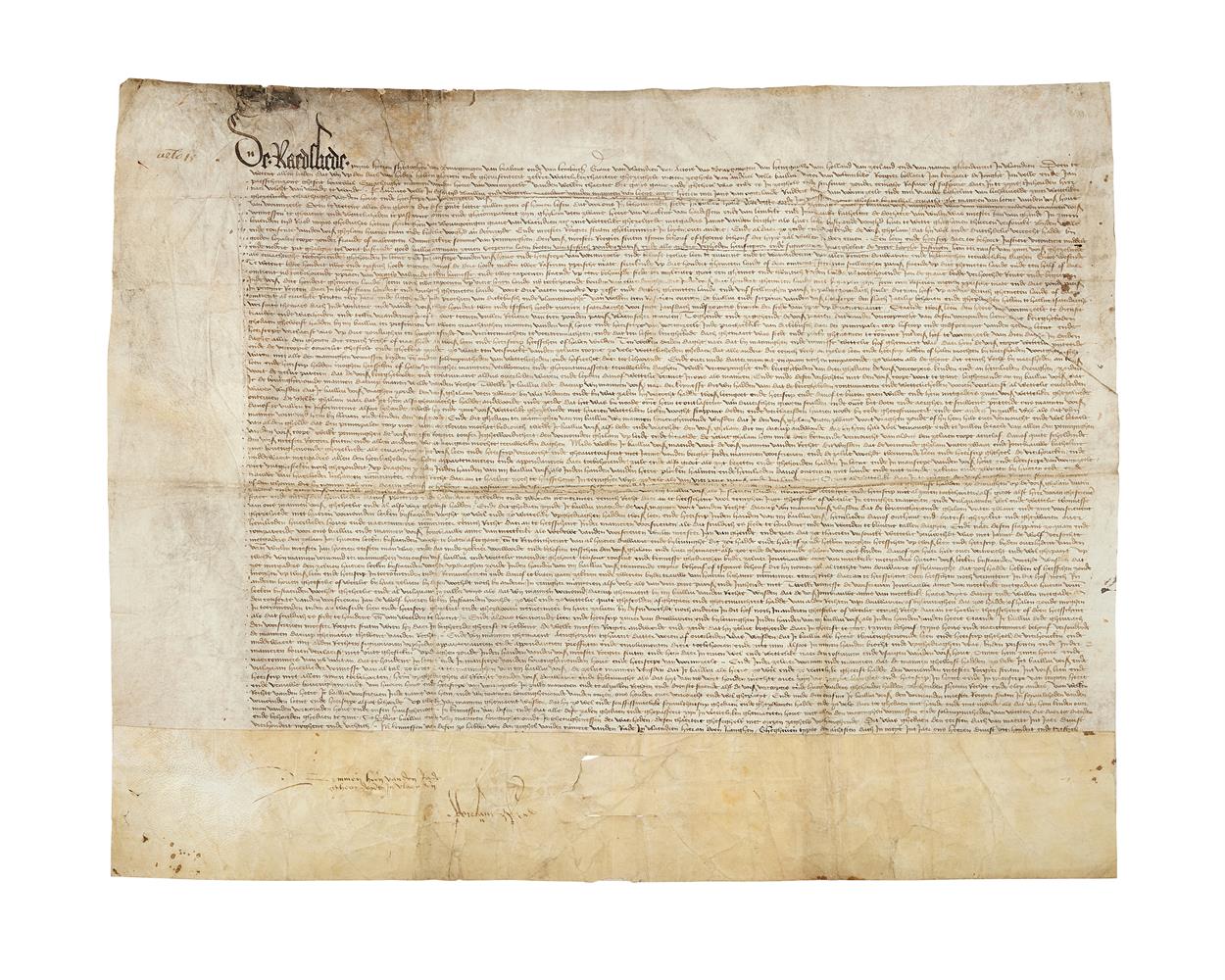Flanders, Philip the Bold, Demi-Noble, Bruges, Ghent or Malines, after 1388, imitating the contemporary English issue, count standing facing in ship, rev. ornate cross, p in centre, 3.78g/8h (Del. 475; SCBI Schneider 154; F 170). Slightly creased and marked, otherwise extremely fine or better and virtually as struck, extremely rare £15,000-20,000 Footnote Provenance: Found in Hampshire. To be recorded in BNS Finds register (BNJ 2012, publication forthcoming). Philip the Bold was the youngest son of John the Good, King of France. At the age of 21 he was given the Duchy of Burgundy as a reward for his valiant behaviour at his father’s side during the Battle of Poitiers in 1356. An advantageous marriage to Margaret of Dampierre, daughter of the count of Flanders, brought him additional territories in the Low Countries on the death of his father-in-law in 1384. The export of English wool to the Low Countries was the basis of the English economy for much of the middle ages. Payments for wool created a steady inflow of bullion to the Exchequer. Over many decades the English tried to control this money by having foreign coins melted and restruck at Calais, the site of the Wool Staple. This incurred extra expense for the foreign merchants and resulted in rivalry between the English and foreign mints to attract bullion. For a brief period at the end of the 14th century, this has been described as the ‘War of the Gold Nobles’. The Flemish gold noble and its fractions was introduced under an Ordinance dated 1 October 1388 and may have been a response by the Flemings to an attempt by the English to insist on payment in nobles for wool purchased at the Calais staple. While the nobles are relatively common, being struck in large quantities to finance international trade, the smaller denominations are rare, the half-noble extremely so. The present specimen is one of just a handful known and a very unusual find from the British Isles. Not surprisingly, it was voted ‘Most significant metal-detecting find of the year’ for 2011 by readers of The Searcher magazine
Flanders, Philip the Bold, Demi-Noble, Bruges, Ghent or Malines, after 1388, imitating the contemporary English issue, count standing facing in ship, rev. ornate cross, p in centre, 3.78g/8h (Del. 475; SCBI Schneider 154; F 170). Slightly creased and marked, otherwise extremely fine or better and virtually as struck, extremely rare £15,000-20,000 Footnote Provenance: Found in Hampshire. To be recorded in BNS Finds register (BNJ 2012, publication forthcoming). Philip the Bold was the youngest son of John the Good, King of France. At the age of 21 he was given the Duchy of Burgundy as a reward for his valiant behaviour at his father’s side during the Battle of Poitiers in 1356. An advantageous marriage to Margaret of Dampierre, daughter of the count of Flanders, brought him additional territories in the Low Countries on the death of his father-in-law in 1384. The export of English wool to the Low Countries was the basis of the English economy for much of the middle ages. Payments for wool created a steady inflow of bullion to the Exchequer. Over many decades the English tried to control this money by having foreign coins melted and restruck at Calais, the site of the Wool Staple. This incurred extra expense for the foreign merchants and resulted in rivalry between the English and foreign mints to attract bullion. For a brief period at the end of the 14th century, this has been described as the ‘War of the Gold Nobles’. The Flemish gold noble and its fractions was introduced under an Ordinance dated 1 October 1388 and may have been a response by the Flemings to an attempt by the English to insist on payment in nobles for wool purchased at the Calais staple. While the nobles are relatively common, being struck in large quantities to finance international trade, the smaller denominations are rare, the half-noble extremely so. The present specimen is one of just a handful known and a very unusual find from the British Isles. Not surprisingly, it was voted ‘Most significant metal-detecting find of the year’ for 2011 by readers of The Searcher magazine



/141904/Photo1%20data.jpg)
/135576/Photo1%20data.jpg)







.jpg)

Testen Sie LotSearch und seine Premium-Features 7 Tage - ohne Kosten!
Lassen Sie sich automatisch über neue Objekte in kommenden Auktionen benachrichtigen.
Suchauftrag anlegen